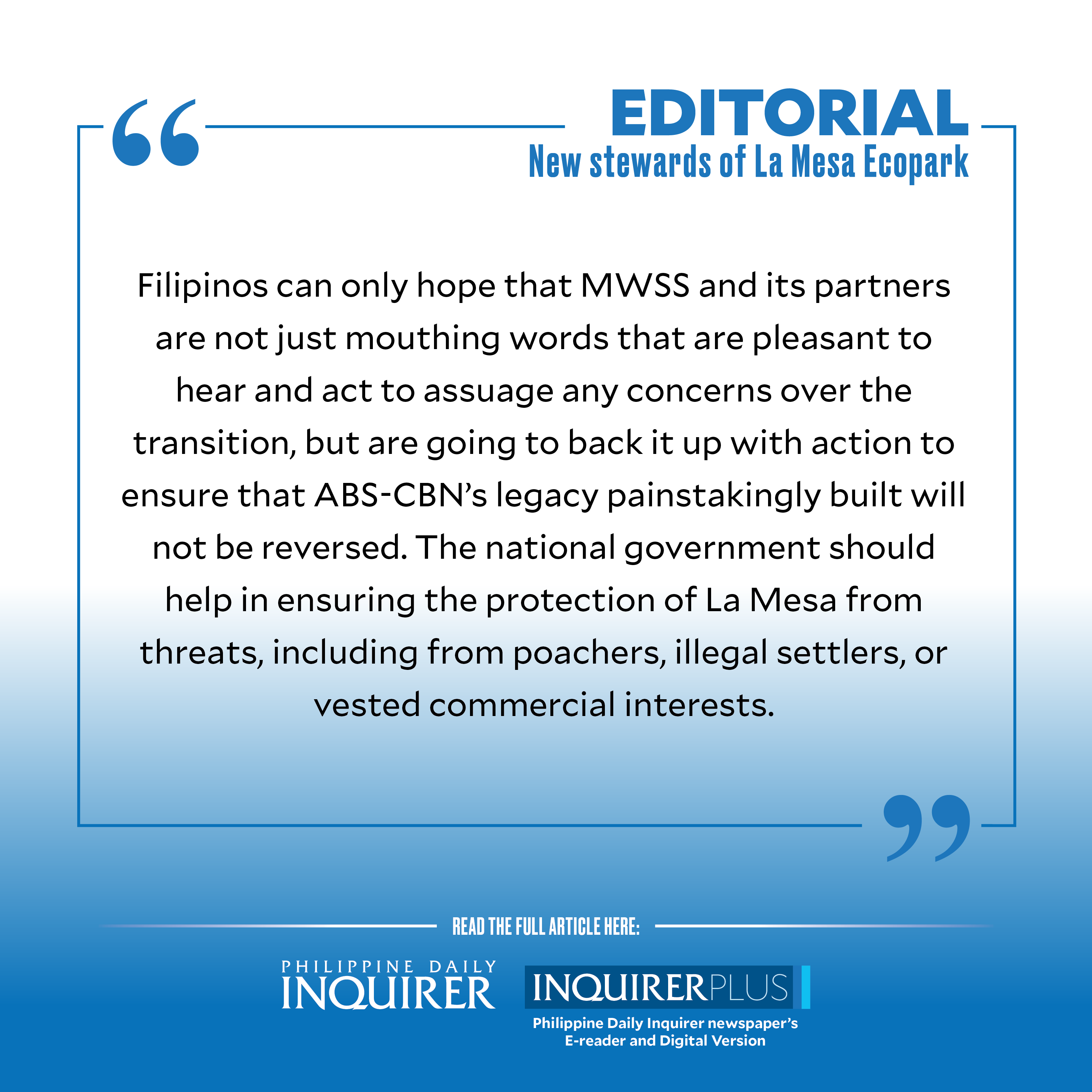New stewards of La Mesa Ecopark
 After almost 25 years, ABS-CBN Foundation Inc. (AFI) is relinquishing its role as steward of the La Mesa Nature Reserve and La Mesa Ecopark, and it is leaving it in a much better state than when it took up the challenge to watch over Metro Manila’s last natural watershed.
After almost 25 years, ABS-CBN Foundation Inc. (AFI) is relinquishing its role as steward of the La Mesa Nature Reserve and La Mesa Ecopark, and it is leaving it in a much better state than when it took up the challenge to watch over Metro Manila’s last natural watershed.
From an ecosystem on the brink of collapse due to illegal loggers and settlers engaged in slash-and-burn agriculture, almost 89 percent of the watershed had been restored since the Lopez-led foundation, through its environmental program Bantay Kalikasan, forged a partnership with the Metropolitan Waterworks and Sewerage System (MWSS) to reforest the 2,700-hectare La Mesa Watershed and develop the 33-ha La Mesa Ecopark for the general public.
Over 1.3 million trees had been planted since 1999 and 92.5 percent of them survived. As a result, wildlife had returned to the lush landscape with some 150 species of birds indigo-banded kingfisher, mangrove-blue flycatcher, ashy thrush, emerald dove, and red-bellied pitta now thriving in the regenerated forest. Some 94 species of native trees had also been introduced, contributing to the tripling of the size of the forest cover over almost 25 years.
Oasis in the heart of the metropolis
With ABS-CBN Foundation’s formal exit last Feb. 15, MWSS and its partners and stakeholders including water distribution concessionaires Maynilad Water Services, Inc. and Manila Water Co., Inc. will now have to carry the torch and ensure that none of the painstaking gains made for more than two decades will be lost, and instead build on them.
After all, the La Mesa complex is much more than just an oasis in the heart of the metropolis, a cool and idyllic place for walking, biking, running, and hiking and learning about the importance of protecting Mother Earth.
It serves a far more strategic purpose as the La Mesa Dam works with the Angat and Ipo dams in Bulacan, and together serve as the main source of potable water for Metro Manila’s more than 14 million population.
It plays a particularly important role during times of distress, as its stored water equivalent to about 19 days of the water requirements of Manila Water Co., Inc. is activated to make up for any slack from Angat.
Onset of El Niño
That La Mesa will step up to the plate is inevitable this year with drought conditions predicted for Metro Manila until May with the onset of the El Niño weather phenomenon, which means three straight months of at least 60 percent reduction in normal rainfall and just when demand picks up because of the heat.
There is, therefore, good reason why the public is anxious about what will happen to the La Mesa Watershed with the departure of AFI, which did not elaborate on its reasons for concluding its stewardship, only that it is a normal transition given the size and scope of the undertaking.
The MWSS will manage La Mesa Nature Reserve with its concessionaires, and will have the local government of Quezon City as its partner in managing the La Mesa Ecopark.
New stewards
There are concerns over whether the new stewards will exhibit the same passion and determination to protect the watershed as the AFI that was guided by the late environmentalist and environment secretary Gina Lopez, who initiated the project.Providing some comfort is the signing of a memorandum of agreement between the MWSS and its two concessionaires last October 2023 for the Integrated Watershed Management Roadmap that includes nurturing and developing the Angat, Ipo, and La Mesa watersheds by 2047.
Manila Water Co., Inc. president and CEO Jose Victor Emmanuel “Jocot” de Dios declared during the signing of the agreement that the company was committed to “ensure a robust and well-protected vibrant watershed.”
MWSS administrator Leonor Cleofas expressed the same commitment to protect the critical watershed: “Ang tubig na dumadaloy sa ating kabayanan ay mananatiling dalisay dahil naalagaan ang pinagmulan nito … Higit sa aming pangangalaga sa tubig, lupa at tao, ang aming pangarap para sa La Mesa Watershed: It is our mission to care for future generations.”
Complex ecosystem
It is essential that these watersheds be protected and nurtured for without them, Metro Manila will simply run out of potable water. Also, they help clean the air by absorbing carbon dioxide and provide a verdant habitat to support a complex ecosystem where plants and animals can survive and thrive.
Filipinos can only hope that MWSS and its partners are not just mouthing words that are pleasant to hear and act to assuage any concerns over the transition, but are going to back it up with action to ensure that ABS-CBN’s legacy painstakingly built will not be reversed. The national government should help in ensuring the protection of La Mesa from threats, including from poachers, illegal settlers, or vested commercial interests.
The baton had been passed, and the government and its partners cannot and must not drop it. Metro Manila’s very survival depends on it.




















